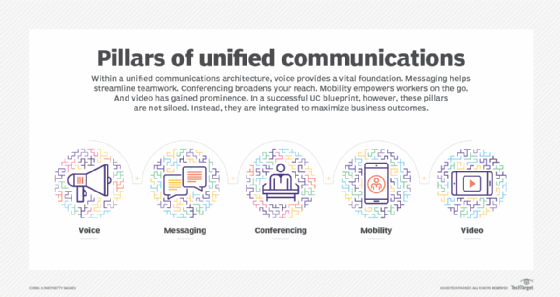
unified communications and collaboration (UCC)
What is unified communications and collaboration (UCC)?
Unified communications and collaboration (UCC) is the collection of technology and software that combines enterprise communication with real-time and asynchronous cooperation capabilities. UCC takes the various methods used in unified communications (UC) and collaboration services and makes them available through a single interface to improve connectivity and productivity.
Key components of UCC include email, voicemail, calendars, scheduling tools, video conferencing, instant messaging, desktop sharing and voice over Internet Protocol, i.e., VoiP. Additional functionality can include integration with existing applications, file sharing and storage options, and tools for tracking audience engagement and other metrics. UCC tools are available through on-premises, cloud-based and hybrid offerings.
Organizations implement UCC technology to streamline employee and customer interactions. Tasks such as brainstorming, virtual meetings and peer feedback can be enhanced by implementing UCC tools. Businesses can also take better advantage of hiring remote or globally dispersed employees with easily accessible communications services that bridge geographical gaps.
Examples of vendors with UCC products include Cisco, Google and Microsoft.

Benefits of UCC
The combination of communications and collaboration tools into a simple interface provides organizations with numerous benefits, including the following:
This article is part of
Ultimate guide on enterprise unified communications strategy
- Increases team collaboration. UCC tools enable more real-time communication and collaborative opportunities by enabling teams to share their screens, edit documents together, give feedback and orchestrate tasks.
- Enables higher accessibility and productivity. Employees can connect and collaborate from any location to work together in a unified environment.
- Reduces cost. Workers can connect remotely, freeing up travel and IT costs.
- Improves customer experience. Tools like interactive voice response can help customers resolve issues more quickly.
- Simplifies processes. The use of artificial intelligence-powered collaboration tools can help increase productivity by automating repetitive tasks, allowing teams to work on other more pressing business.
Challenges of UCC
However, UCC poses several challenges to networks with old infrastructure, having changed the nature of enterprise network workloads. In a network with separate compute and storage, these dynamic workloads can result in latency and congestion. As UCC and other dynamic workloads have increased, they've driven the adoption of hyperconverged networks to deal with the attendant challenges.
Use cases
UCC tools can be used in many different business environments and processes, including the following:
- Enterprise. While all aspects of business revolve around proper communication and collaboration, UCC tools are especially helpful with product development. Streamlined communication channels can also help reduce time wasted when waiting for a response and improve operational efficiency.
- Education. UCC tools can enhance learning experiences for students by enabling live teaching sessions, video conference review sessions and real-time file sharing.
- Healthcare. Healthcare providers can take advantage of UCC services to provide telehealth services, share patient information and consult with additional medical personnel before diagnosis. Tools can also be used to simplify scheduling.
- Marketing. The marketing industry uses UCC platforms to enable coordination among teams, thereby increasing the efficiency of planning and executing campaigns across different channels. UCC tools can also help marketing departments track audience engagement and other key performance indicators.
- Retail. The retail industry uses UCC platforms to increase communication between store locations and associates, while also increasing operational efficiency.

UCC tools and vendors
Examples of UCC tools and vendors include the following:
- Avaya IP Office. This communications and collaboration platform supports cloud, on-premises or hybrid deployments and offers a single app for messaging, voice, video, conferencing and calendar functions.
- Cisco Webex. This dedicated UC platform offers virtual meetings, messaging, webinars, interactive features for polling and event management tools.
- Google Meet. This video communication service offers online video calls, screen sharing, audio and visual preview, and integrations and collaboration across Google Workspace.
- Microsoft Teams. This team collaboration software offers messaging, screen-sharing, voice calling and video meetings via desktop and the Microsoft Teams mobile app.
- Slack. Slack, now owned by Salesforce, offers messaging, channels and integrations with other applications such as GitHub, Google Drive or Zendesk.
- Zoom. The Zoom platform offers audio, video and whiteboard tools, in-call chat functions, integrations, document sharing and cloud file storage. Zoom can also track audience engagement and other metrics.
There are many different tools and strategies available for businesses to integrate internal communication services. Learn about several UC and collaboration trends.







